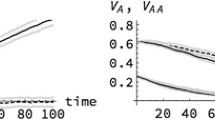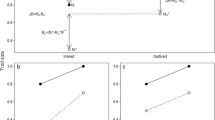Abstract
There is substantial new variation for quantitative traits generated by mutation that can be utilised by artificial selection. With long-term selection, however, response is often attenuated and a selection limit sometimes reached, even though genetic variation is frequently still present in these lines. In this paper, the theoretical bases of long-term response and variability of populations that come from mutational variance are reviewed, and the relation between them is related to the strength and mode of the natural selection, whether due to pleiotropic effects of mutant genes or stabilising selection. Simple formulae to predict the consequence of relaxed or reversed selection are derived. Results from long-term selection experiments in mice in this laboratory are described and related to the theoretical analyses with the aim of reconciling the evidence for substantial standing variation with the low rate of response.
Access this chapter
Tax calculation will be finalised at checkout
Purchases are for personal use only
Preview
Unable to display preview. Download preview PDF.
Similar content being viewed by others
References
Barton, N., 1990. Pleiotropic models of quantitative variation. Genetics 124: 773–782.
Beniwal, B.K., I.M. Hastings, R. Thompson & W.G. Hill, 1992a. Estimation of changes in genetic parameters in selected lines of mice. 1.Lean mass. Heredity 69: 352–360.
Beniwal, B.K., I.M. Hastings, R. Thompson & W.G. Hill, 1992b. Estimation of changes in genetic parameters in selected lines of mice. 2.Body weight, body composition and litter size. Heredity 69: 361–371.
Bulmer, M.G., 1971. The effect of selection on genetic variability. Amer. Nat. 105: 201–211.
Bünger, L. & G. Herrendörfer, 1994. Analysis of a long-term selection experiment with an exponential model. J.Anim.Breed. Genet. 111: 1–13.
Caballero, A., P.D. Keightley & W.G. Hill, 1995. Accumulation of mutations affecting body weight in inbred mouse lines. Genet. Res. 65: 145–149.
Caballero. A., M.A. Toro & C. López-Fanjul, 1991. The response to artificial selection from new mutations in Drosophila melanogaster. Genetics 127: 89–102.
Clayton, G.A. & A. Robertson, 1955. Mutation and quantitative variation. Amer. Nat. 89: 151–158.
Dickerson, G.E., 1955. Genetic slippage in response to selection for multiple objectives. Cold Spring Harbor Symp. Quant. Biol. 20: 213–224.
Dudley, J.W. & J.R. Lambert, 1992. Ninety generations of selection for oil and protein content in maize. Maydica 37: 1–7.
Eisen, E.J., 1980. Conclusions from long-term selection experiments with mice. Z. Tierzüchtg. Züchtungsbiol. 97: 305–319.
Falconer, D.S., 1960. Introduction to Quantitative Genetics. Oliver and Boyd, Edinburgh.
Falconer, D.S. & T.F.C. Mackay, 1996. Introduction to Quantitative Genetics. 4th ed. Longman, Harlow, UK.
Fisher, R.A. 1930. The Genetical Theory of Natural Selection. Oxford University Press, Oxford.
Frankham, R., 1980. Origin of genetic variation in selection lines, pp. 56–68 in Selection experiments in laboratory and domestic animals, edited by A. Robertson. Commonwealth Agricultural Bureaux, Slough, UK.
Franklin, I.R., 1980. Evolutionary change in small populations. pp. 135–149 in Conservation biology: An evolutionary perspective, edited by M.E. Soulé and B.A. Wilcox, Sinauer, Sunderland, MA.
Hastings, I.M. & R. F. Veerkamp, 1993. The genetic basis of response in mouse lines divergently selected for body weight or fat content. I. The relative contributions of autosomal and sex-linked genes. Genet. Res. 62: 169–175.
Hill, W.G., 1982. Predictions of response to artificial selection from new mutations. Genet. Res. 40: 255–278.
Hill, W.G. & P.D. Keightley, 1988. Interrelations of mutation, population size, artificial and natural selection pp. 57–70 in Proc.2nd Int. Conf. Quant. Genet., edited by B.S. Weir, E.J. Eisen, M.M. Goodman & G. Namkoong. Sinauer, Sunderland, MA.
Hill, W.G. & A. Robertson, 1966. The effect of linkage on limits to artificial selection. Genet. Res. 8: 269–294.
James, J.W., 1962. Conflict between directional and centripetal selection. Heredity 17: 487–499.
Keightley, P.D. & W.G. Hill, 1988. Quantitative genetic variabili ty maintained by mutation-stabilizing selection balance in finite populations. Genet. Res. 52: 33–43.
Keightley, P.D. & W.G. Hill, 1990. Variation maintained in quan titative traits with mutation-selection balance: pleiotropic sideeffects on fitness traits. Proc. Roy. Soc. Lond. B242: 95–100.
Keightley, P.D. & W.G. Hill, 1992. Quantitative genetic variation in body size of mice from new mutations. Genetics 131: 693–700.
Keightley, P.D., T.F.C. Mackay & A. Caballero, 1993. Account ing for bias in estimates of the rate of polygenic mutation. Proc.Roy.Soc.Lond B253: 291–296.
Kimura, M., 1969. The number of heterozygous nucleotide sites maintained in a finite population due to steady flux of mutations. Genetics 61: 893–903.
Lande, R., 1975. The maintenance of genetic variability by mutation in a polygenic character with linked loci. Genet. Res. 26: 221–235.
López, M.A. & López-Fanjul, C., 1993. Spontaneous mutation for a quantitative trait in Drosophila melanogaster. II. Distribution of mutant effects on the trait and fitness. Genet. Res. 61: 117–126.
Lynch, M. & W.G. Hill, 1986. Phenotypic evolution by neutral mutation. Evolution 40: 915–935.
Mackay, T.F.C., 1984. Jumping genes meet abdominal bristles: Hybrid dysgenesis-induced quantitative variation in Drosophila melanogaster. Genet. Res. 44: 231–237.
Mackay, T.F.C., J.D. Fry, R.F. Lyman & S.V. Nuzhdin, 1994. Polygenic mutation in Drosophila melanogaster: estimates from response to selection of inbred strains. Genetics 136: 937–951.
Mather, K. & L.G. Wigan, 1942. The selection of invisible mutations. Proc. Roy. Soc. Lond. B131: 50–64.
Mbaga, S.H., 1996. Analysis and inferences from long-term quanti tative genetic selection experiments. Ph D Thesis, University of Edinburgh.
Merchante, M., A. Caballero & C. López-Fanjul, 1995. Response to selection from new mutation and effective size of partially inbred populations.II.Experiments with Drosophila melanogaster. Genet. Res. 66: 227–240.
Nicholas, F.W. & A. Robertson, 1980. The conflict between natural and artificial selection in finite populations. Theor. Appl. Genet. 56: 57–64.
Rance, K.A., W.G. Hill & P.D. Keightley, 1997. Mapping quantita tive trait loci for body weight on the X-chromosome in mice. I. Analysis of a reciprocal F2 population. Genet. Res. 0: 117–124.
Robertson, A., 1960. A theory of limits in artificial selection. Proc. Roy. Soc. Lond. B153: 234–249.
Robertson, A., 1966. A mathematical model of the culling process in dairy cattle. Anim. Prod. 8: 95–108.
Robertson, A., 1967. The nature of quantitative genetic variation. pp. 265–280 in Heritage from Mendel, edited by R.A. Brink & R.A. Styles. Univ. Wisconsin Press, Madison, WI.
Robertson, F.W., 1955. Selection response and the properties of genetic variation. Cold Spring Harbor Symp. Quant. Biol. 20: 166–177.
Sharp, G.L., W.G. Hill & A. Robertson, 1984. Effects of selection on growth, body composition and food intake in mice. I. Responses in selected traits. Genet. Res., 43: 75–92.
Sorensen, D.A. & B.W. Kennedy, 1984. Estimation of genetic vari ance from selected and unselected populations. J. Anim. Sci. 59: 1213–1223.
Turelli, M., 1984. Heritable genetic variation via mutation-selection balance: Lerch’s zeta meets the abdominal bristle. Theor. Pop. Biol. 25: 138–193.
Turelli, M. 1985. Effects of pleiotropy on predictions concerning mutation-selection balance for polygenic traits. Genetics 111: 165–195.
Weber, K.E., 1996. Large genetic change at small fitness cost in large populations of Drosophila melanogaster selected for wind tunnel flight: rethinking fitness surfaces. Genetics 144: 205–213.
Wei, M., A. Caballero & W.G. Hill, 1996. Selection response in finite populations. Genetics 144: 1961–1974.
Wray, N.R., 1990. Accounting for mutation effects in the additive genetic variance-covariance matrix and its inverse. Biometrics 46: 177–186.
Wright, S., 1935. The analysis of variance and the correlations between relatives with respect to deviations from an optimum. J. Genet. 30: 257–266.
Zeng, Z.-B. & C. C. Cockerham, 1993. Mutation models and quan titative variation. Genetics 133: 729–736.
Zeng, Z.-B. & W G. Hill, 1986. The selection limit due to the con flict between truncation and stabilising selection with mutation. Genetics 114: 1313–1328.
Author information
Authors and Affiliations
Editor information
Editors and Affiliations
Rights and permissions
Copyright information
© 1998 Springer Science+Business Media Dordrecht
About this chapter
Cite this chapter
Hill, W.G., Mbaga, S.H. (1998). Mutation and conflicts between artificial and natural selection for quantitative traits. In: Woodruff, R.C., Thompson, J.N. (eds) Mutation and Evolution. Contemporary Issues in Genetics and Evolution, vol 7. Springer, Dordrecht. https://doi.org/10.1007/978-94-011-5210-5_15
Download citation
DOI: https://doi.org/10.1007/978-94-011-5210-5_15
Publisher Name: Springer, Dordrecht
Print ISBN: 978-94-010-6193-3
Online ISBN: 978-94-011-5210-5
eBook Packages: Springer Book Archive




